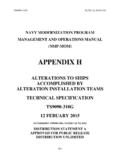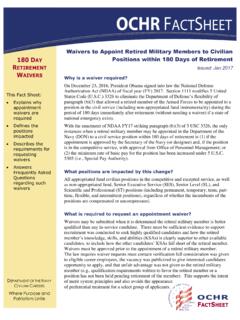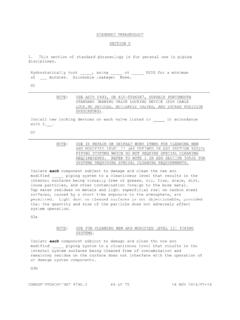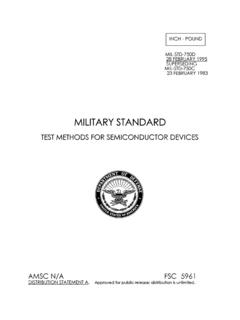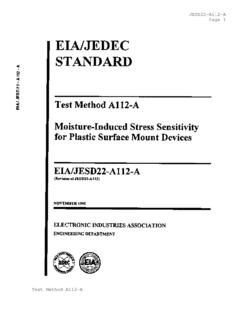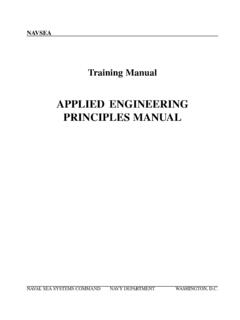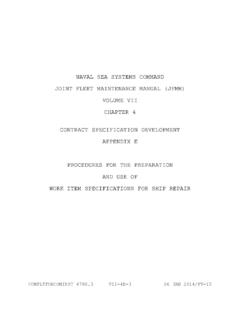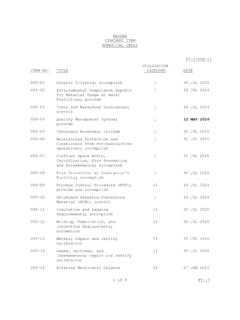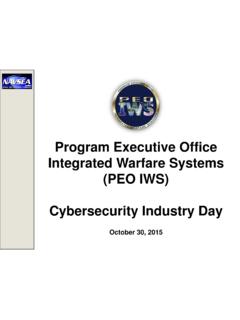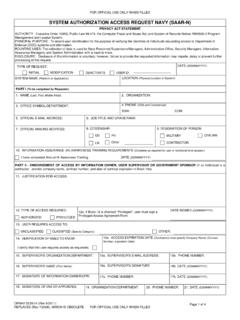Transcription of DEPARTMENT OF DEFENSE STANDARD PRACTICE
1 NOT MEASUREMENT SENSITIVEMIL-STD-1686C 25 October 1995 SUPERSEDINGMIL-STD-1686B31 December 1992 DEPARTMENT OF DEFENSESTANDARD PRACTICEELECTROSTATIC DISCHARGE CONTROL PROGRAM FOR PROTECTION OF ELECTRICAL AND ELECTRONIC PARTS,ASSEMBLIES AND EQUIPMENT (EXCLUDINGELECTRICALLY INITIATED EXPLOSIVE DEVICES)AMSC N/AAREA RELIMIL-STD-1686 CiiFOREWORD1. This STANDARD is approved for use by all Departments andAgencies of the DEPARTMENT of This STANDARD covers the establishment andimplementation of an Electrostatic Discharge (ESD) ControlProgram for any activity that designs, tests, inspects, services,manufactures, processes, assembles, installs, packages, labels,or otherwise handles electrical or electronic parts, assembliesand equipment susceptible to damage by static electricity.
2 Thisdocument provides control program requirements for ESD sensitive(ESDS) items susceptible to damage from discharges of up to15,999 volts Human Body Model (HBM) Classes 1-3. This standarddoes not apply to electrically initiated explosive devices orpart level design requirements. MIL-HDBK-263 provides additionalinformation relative to the implementation of this Electrostatic charges are generated by the relativemotion, physical separation of materials or flow of solids,liquids, or gases. Common sources of ESD include personnel,items made of common plastics, and processing equipment. ESD candamage parts by direct contact with a charged source or bycharges induced from electrostatic fields. Examples of ESDS parts are micro-circuits, discrete semiconductors, thick and thinfilm resistors, hybrid devices and piezoelectric Beneficial comments (recommendations, additions,deletions) and any pertinent data which may be of use inimproving this document should be addressed to: Commander, NavalSea Systems Command, SEA 03R42, 2531 Jefferson Davis Highway,Arlington, VA 22242-5160, by using the Standardization DocumentImprovement Proposal (DD Form 1426) appearing at the end of thisdocument or by PARAGRAPH ii1.
3 SCOPE 12. APPLICABLE DOCUMENTS Government Specifications, standards, Non-Government Order of 43. DEFINITIONS 54. GENERAL REQUIREMENTS Tailoring of this 55. DETAILED REQUIREMENTS ESD control program Subcontractor Classification of ESDS parts,assemblies and Part ESD sensitivity classes HBM sensitivity MM sensitivity CDM sensitivity Assembly/Equipment classificationand design Direct contact, non-operatingassembly, 2,000 V body/finger orhand/metal HBM Direct contact, operating equipment,4,000 V hand/metal HBM Indirect contact, operatingequipment, 4.
4 000 V furnituremodel 11 MIL-STD-1686 CivCONTENTSPARAGRAPH Protected Handling Protective Marking of Quality assurance reviews and audits. Failure 136. NOTES Intended Issue of Subject term (key word) Changes from previous 14 FIGURE1. Tailoring flow 62. Electrostatic discharge 12 TABLEI. Classes of ESDS 7II. ESD test standards/methods forclassification of ESDS 8 III.
5 ESD assembly/equipment designhardening 10IV. ESD test standards/methods forhardening of ESDS assembly/equipment. 11 MIL-STD-1686C11. Purpose. The purpose of this STANDARD is to establishcomprehensive requirements for an ESD control program to minimizethe effects of ESD on parts, assemblies, and equipment. Aneffective ESD control program will increase reliability anddecrease both maintenance actions and lifetime costs. Thisstandard shall be tailored for various types of Scope. This STANDARD defines the performancerequirements for an ESD control program for electrical andelectronic parts, assemblies, and equipment, susceptible todamage from ESD. Electrically initiated explosive devices andpart level design are excluded from these requirements.
6 Thisstandard covers identification, testing, classification, assemblyand equipment design criteria, protected areas, handlingprocedures, training, marking of hardware, protective coveringand packaging, and provides for quality assurance requirements,audits and Application. This STANDARD shall apply to Governmentactivities and contractors, subcontractors, suppliers, andvendors. When this STANDARD is applied to Government activitiesthe term "contractor" shall be replaced with "Governmentactivity" as APPLICABLE General. The documents listed in this section arespecified in sections 3,4, and 5 of this STANDARD . This sectiondoes not include documents cited in other sections of thisstandard or recommended for additional information or asexamples. While every effort has been made to ensure thecompleteness of this list, document users are cautioned that theymust meet all specified requirements documents cited in sections3,4, and 5 of this STANDARD , whether or not they are Government Specifications, standards, and handbooks.
7 Thefollowing standards and handbook form a part of this document tothe extent specified herein. Unless otherwise specified, theissues of these documents are those listed in the issue of theDepartment of DEFENSE Index of Specifications and StandardsMIL-STD-1686C2(DoDISS) and supplement thereto, cited in the solicitation( ).STANDARDSMILITARYMIL-STD-750 - Test Methods for - Test Methods and Proceduresfor - DOD Materiel Procedures forDevelopment and Application ofPackaging - Packaging Requirement - Electrostatic DischargeControl Handbook forProtection of Electrical andElectronic Parts, Assemblies,and Equipment (ExcludingElectrically InitiatedExplosive Devices). (Metric)(Unless otherwise indicated, copies of federal and militaryspecifications, standards, and handbooks are available from theStandardization Documents Order Desk, Bldg.)
8 4D, 700 RobbinsAvenue, Philadelphia, PA 19111-5094.) Non-Government publications. The following documentsform a part of this document to the extent specified otherwise specified, the issues of the documents which areDoD adopted are those listed in the issue of the DoDISS cited inthe solicitation. Unless otherwise specified, the issues ofdocuments not listed in the DoDISS are the issues of thedocuments cited in the solicitation(see ).MIL-STD-1686C3 AMERICAN NATIONAL STANDARD INSTITUTE (ANSI)ANSI - American National STANDARD Guidefor Electrostatic Discharge TestMethodologies and Criteria forElectronic Equipment(Application for copies should be addressed to the Instituteof Electrical and Electronics Engineers, Inc., 445 Hoes Lane, Box 1331, Piscataway, NJ 08855-1331.
9 AMERICAN SOCIETY FOR TESTING AND MATERIALS (ASTM)F 1166 - Human Engineering Design for Manned Systems, Equipment and Facilities(Application for copies should be addressed to the AmericanSociety for Testing and Materials, 1916 Race Street,Philadelphia, PA 19103.)ELECTROSTATIC DISCHARGE (ESD) - EOS/ESD association STANDARD for ESD Sensitivity Testing, Human Body Model(HBM) - Component - ESD association STANDARD for ESDS ensitivity Testing, Machine Model (MM)- Component - ESD association STANDARD for ESDS ensitivity Testing, Charged DeviceModel (CDM) - Component Level(Application for copies should be addressed to the ESDA ssociation, Inc., 7902 Turin Road, Suite 4, Rome, NY 13440-2069.)ELECTRONIC INDUSTRIES association (EIA)RS-471 - Symbol and Label for ElectrostaticSensitive Devices.
10 (Application for copies should be addressed to theElectronic Industries association , 2500 Wilson Boulevard,Arlington, VA 22201-3834.)MIL-STD-1686C4 INSTITUTE OF ELECTRICAL AND ELECTRONICS ENGINEERS (IEEE)IEEE STD - IEEE Guide on ESD: ESD Withstand Capability Evaluation Methods (for Electronic Equipment Subassemblies)(Application for copies should be addressed to the Instituteof Electrical and Electronics Engineers, Inc., 445 Hoes Lane, Box 1331, Piscataway, NJ 08855-1331.)INTERNATIONAL ELECTROTECHNICAL COMMISSION (IEC)IEC 801-2 - (First Edition, 1984) ElectromagneticCompatibility for Industrial ProcessMeasurement and Control Equipment, Part 2: Electrostatic Discharge RequirementsIEC 801-2 - (Second Edition, 1991-04) Electromagnetic Compatibility for Industrial Process Measurement and Control Equipment, Part 2: Electrostatic Discharge Requirements(Application for copies should be addressed to the AmericanNational STANDARD Institute, 1430 Broadway, New York, NY 10018.)
